



Late Antique motifs of scrolling vines and vases; similar designs found in mosaic and stucco from Ctesiphon and Siraf.
Included are: ME OA 1981.8-7.1, 1990.5-30.7, 8; 1996.5-23.4


Syria and Jordan, the unglazed one from Deir Ain Abata. 8th-10th c. CE. The vine and scroll motifs are Late Antique.
ME OA 1973.3-17.1; DAA RN 74.1.147
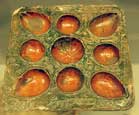
Egypt, 9th c. CE. Width: 34.9 cm. Made by Abu Nasr of Basra (Iraq) but in Egypt; shows legacy of Roman moulded relief ware.
ME OA 1889.7-6.75
Learn more. Compare LACMA M.2002.1.20.

Iraq, ca. 9th c. CE (?)

Egypt (?), ca. 9th c. CE.
Collection of Sir Sydney Burney.
Compare LACMA M.73.5.405

Iraq, Samarra, 9th-10th c. CE.
Compare a similar fragment on display in the Museum für Islamische Kunst in Berlin.
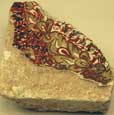

Iraq, Samarra, audience hall of main palace. Ca. 9th c. CE. The design contained repeated patterns showing a cockeral surrounded by wreaths.
ME OA 2271.10624.1, 2

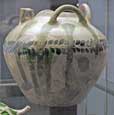
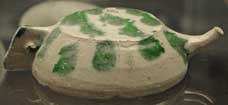
Iraq, 9th c. CE. The shape is based on T'ang Chinese export ware. The lid here is from a different vessel, but is similar to the one which would have been made for this pot.
ME OA 1936.3-101; +2065

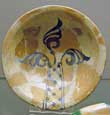
Iraq, 9th c. CE. Influenced by Chinese porcelain designs.
ME OA 1956.7-28.1; 1923.7-25.1

Iraq, 9th-10th c. CE. Influenced by Chinese porcelain designs.
ME OA 1926.3-19.11
Cf. an analogous ceramic bowl from 9th c. CE Egypt, Inv. no. ME OA 1994.6-2.1.
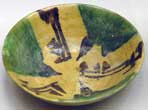
Iraq, 9th-10th c. CE, the inscription repeating word "baraka" (blessing).
ME OA 1925.11-30.3

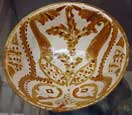
Iraq, 9th-10th c. CE. Design on second loosely based on Sasanian crown shown on coins of Khusraw II.
ME OA 1965.4-14.1; 1965.7-30.1

Iraq, 9th-10th c. CE.
ME OA 1953.10-22.1

Iran, Samanid period, 9th-10th c. CE. Reddish-brown earthenware, with incised vegetal and geometric decoration; green, yellow and purple splash over white slip, under colorless transparent glaze.
ME OA 1951.10-9.4
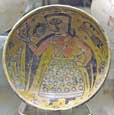
Iran, Nishapur. Samanid period, 10th c. CE. Buff earthenware, slip-painted under transparent glaze; sgraffiato incised decoration.
ME OA 1959.4-13
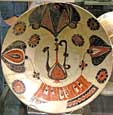
Iran, Samanid period, 10th c. CE. Reddish-brown earthenware, slip-painted under transparent glaze. Decoration includes pseudo-calligraphy.
ME OA 1956.7-28.3
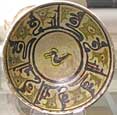
Iran, Nishapur (?), 10th c. CE. Earthenware, slip-painted under transparent glaze.
Cf. LACMA M.68.37.7.
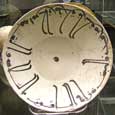
Iran, Nishapur, 11th c. CE. Earthenware, with inscription: "He who speaks, his speech is silver, but silence is a ruby." Dia.: 34.6 cm.
ME OA 1958.12-18.1
Learn more. Compare: LACMA M.68.22.9, a Nishapur bowl dated to 10th c.; Freer Gallery F.1952.11, a 10th-century Samanid plate; Louvre AA 96, a Khurasan plate of 11h-12th c. CE.
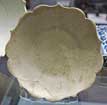
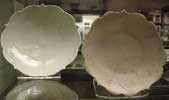
Iran, 12 c. CE. Copies shape of Chinese porcelain, an example of which from the 9th century is shown for comparison.
ME OA 1956.3-31.1; comparison dish: OA 1976.11-3.1.
For an analogous Middle-Eastern dish, see Berlin Museum für Islamische Kunst, Inv. no. I.32/63, dated to the 11th century.

Iran, late 12th c. CE. Moulded ceramic. H.: 14 cm.
ME OA 1966.6-13.1
Learn more.
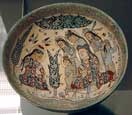
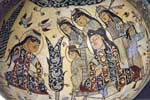
Iran, Kashan, dated AH 583/CE 1187, signed by Abu Zayd. Fritware, underglaze-painted, overglaze-enameled haft rang or mina'i decoration. Dia.: 21.1 cm.
ME OA 1945.10-17.261.
Learn more. For a very similar example of the same date, compare LACMA M.45.3.116.
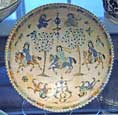
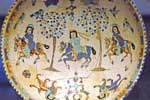
Iran, probably Kashan, late 12th c. Fritware, underglaze-painted, overglaze-enameled haft rang or mina'i decoration.
ME OA 1930.7-19.64.
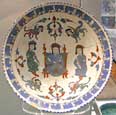
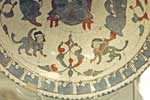
Iran, Kashan, late 12th-early 13th c. CE. Fritware, underglaze-painted, overglaze-enameled haft rang or mina'i decoration.
ME OA 1930.7-19.63.

Iran, Kashan, late 12th-early 13th c. CE. Fritware, underglaze-painted, overglaze-enameled haft rang or mina'i decoration.
ME OA 1912.12-7.4.
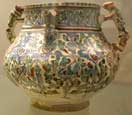
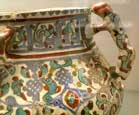




Iran, Kashan, early 13th c. CE. Fritware, underglaze-painted, overglaze-enameled haft rang or mina'i decoration.
ME OA 1930.7-19.65.
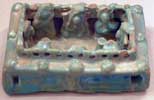
Iran, Zanjan, near Tabriz, 13th CE. Ceramic stonepaste body with opaque turquoise glaze.
ME OA 1886.8-3.1. Compare Louvre MAO 492.
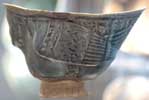
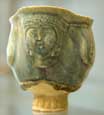
Iran, Late 12th-early 13th c. CE. Fritware. L.: 12.7 cm.
ME OA 1965.10-11.1
Learn more.

Iran, early 13th c. CE.
ME OA 1928.7-21.10
Compare LACMA M.73.5.191, a Kashan-ware seated musitian from the 13th century; and a Kashan-ware bottle in the form of a seated man, collection of the Victoria and Albert Museum.

Iran, Kashan or Rayy, early (?) 13th c. CE.
Compare Freer Gallery S1987.83, a Kashan-ware bottle dated ca. 1200-1300.

Iran, early 13th c. CE. Impressed terracotta.
ME OA 1985.2-3.1
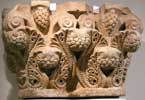
Jerusalem, the Haram al-Sharif (location of the Dome of the Rock), ca. 12 c. CE. Limestone.
ME OA 1903.2-20.4
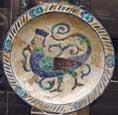
Northern Syria, 2nd half of 12 c. CE. Fritware, incised and painted under transparent glaze, so-called laqabi technique. Dia.: 41.5 cm.
ME OA 1923.2-17.1
Learn more. Compare Freer Gallery F.1929.11.

Northern Syria, 13th c. CE. Fritware, incised and painted under transparent glaze, so-called laqabi technique.
ME OA 1945.10-17.262

Found near Aleppo, Syria, 13th c. CE. Slip-painted, sgraffiato incised pottery, following popular techniques and styles from earlier Samanid period in Iran.
ME OA 1931.7-16.1
Learn more. Note on BM website, the image is reversed. The horse and rider face left.
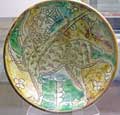
Found near Mina on coast of Syria, 13th-14th c. CE. Sgraffiato incised pottery.
ME OA 1937.3-17.5